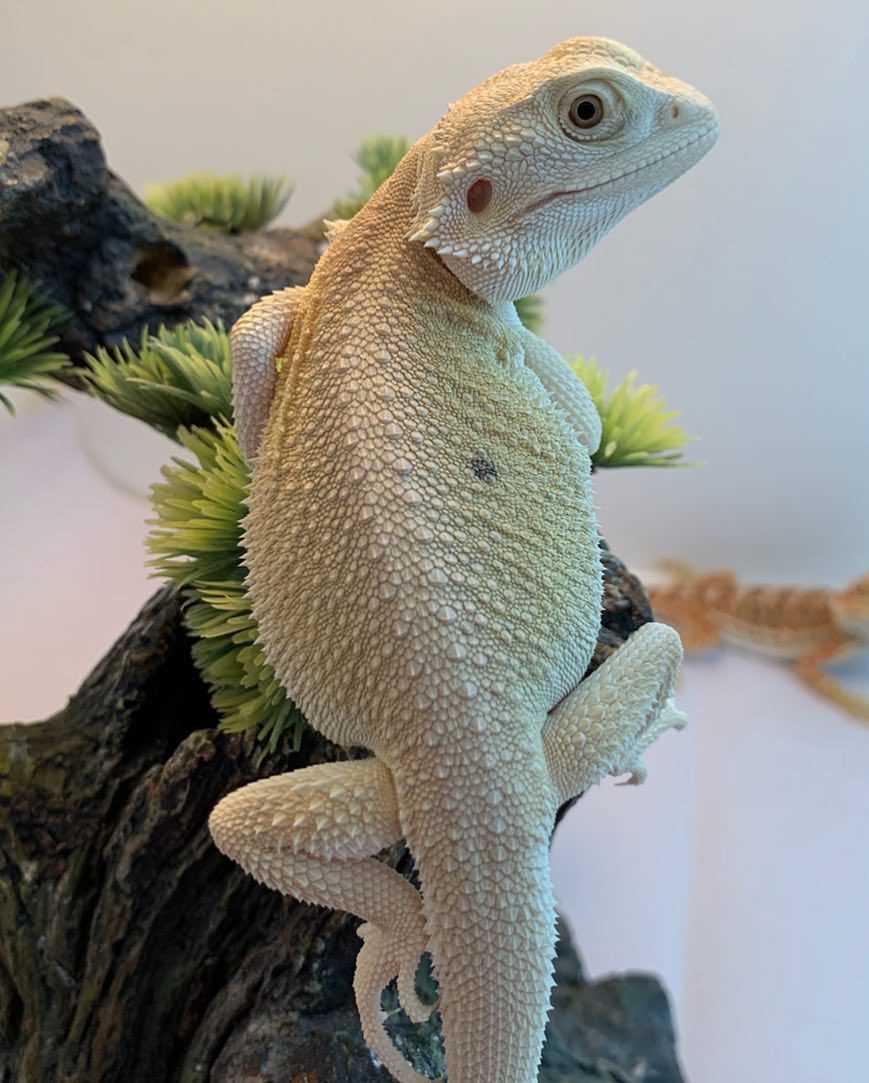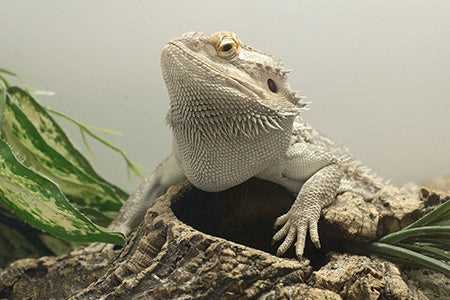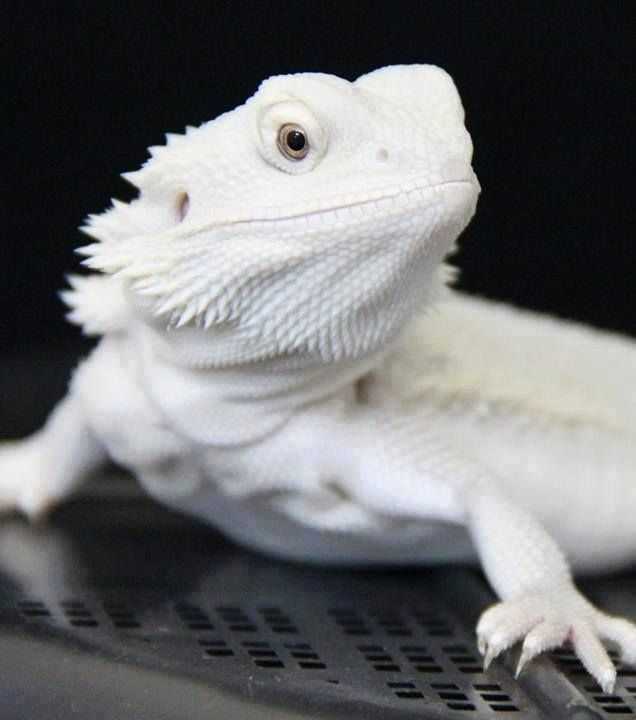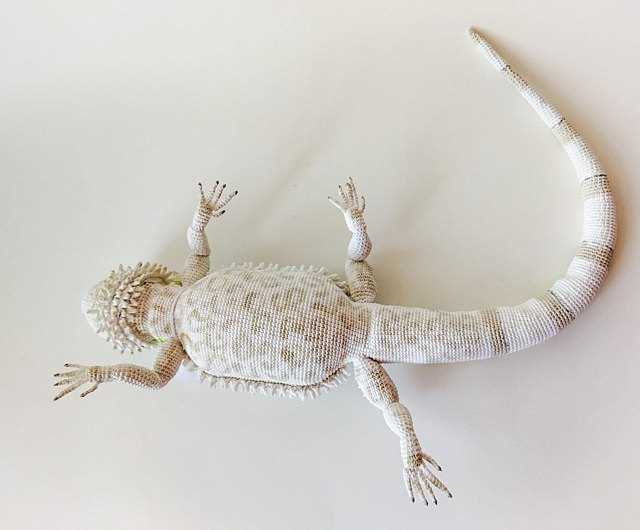
The albino bearded dragon is a stunning variation of the traditional bearded dragon, boasting a strikingly beautiful white or pale yellow coloration. Its bright red or orange eyes add to its otherworldly charm. This mesmerizing appearance is the result of a genetic mutation that affects pigmentation, making the albino bearded dragon a truly unique and sought-after pet among reptile enthusiasts.
Characteristics of Albino Bearded Dragons
Albino bearded dragons are a unique and fascinating variety of the popular reptile species known for their distinct characteristics and appearance. They are a result of selective breeding and have become increasingly sought after by reptile enthusiasts. Here are some key characteristics of albino bearded dragons:
- Eye Color: One of the most striking features of albino bearded dragons is their vibrant red or pink eyes. This is due to the absence of pigment in the irises.
- Pattern: Unlike their wild-type counterparts, albino bearded dragons have a more uniform and consistent scale pattern. This adds to their overall unique and eye-catching appearance.
- Growth Rate: Albino bearded dragons generally grow at a similar rate to other bearded dragon morphs. However, individual growth rates can vary depending on factors like diet, habitat conditions, and genetics.
- Size: Similar to other bearded dragon morphs, albino bearded dragons reach an average length of 18-24 inches when fully grown. Males tend to be slightly larger than females.
- Temperament: Albino bearded dragons have a reputation for being docile and easy to handle. They are generally friendly and can be quite interactive with their owners.
- Lifespan: With proper care, albino bearded dragons can live for 8-12 years or even longer. Their lifespan is influenced by factors like diet, habitat conditions, and overall health care.
Overall, albino bearded dragons are a visually striking variant of bearded dragons. Their lack of melanin and unique eye color make them stand out among other morphs. If properly cared for, these reptiles can make wonderful pets and additions to any reptile enthusiast’s collection.
Appearance and Coloration of Albino Bearded Dragons
Albino bearded dragons are a unique and fascinating variation of the popular bearded dragon species. These dragons are characterized by their lack of melanin, which gives them their distinct albino appearance. Unlike their normal counterparts, albino bearded dragons lack the pigmentation that typically gives them a range of colors and patterns.
Due to the absence of melanin, albino bearded dragons have a pale, almost translucent skin tone. Their scales are typically lighter in color compared to normal bearded dragons, often appearing more yellow or cream-colored. This lack of pigmentation extends to their eyes as well, which are usually a vibrant shade of red or pink due to the blood vessels showing through the transparent irises.
In terms of physical features, albino bearded dragons possess the same characteristics as other bearded dragon morphs. They have a robust body with a triangular-shaped head, covered in spiky scales that resemble a beard. These dragons also have strong limbs with sharp claws, which aid them in their climbing abilities.
Despite their lack of pigmentation, albino bearded dragons can still exhibit variations in coloration. Some individuals may have patches of pale yellow or white scales mixed in with their overall lighter color. These color variations can make each albino bearded dragon unique, with their own individual pattern and appearance.
- Albino bearded dragons have a pale, almost translucent skin tone.
- Their scales are typically lighter in color, often appearing more yellow or cream-colored.
- Albino bearded dragons have vibrant red or pink eyes due to the transparent irises.
- They possess the same physical features as other bearded dragon morphs, including a triangular-shaped head and spiky scales.
- Some albino bearded dragons may have patches of pale yellow or white scales mixed in with their overall lighter color.
- They are genetically sensitive to sunlight and require appropriate UVB lighting and access to shaded areas for protection.
Overall, albino bearded dragons offer an intriguing and unique visual experience for reptile enthusiasts. Their lack of pigmentation sets them apart from other bearded dragon morphs, making them a captivating addition to any reptile collection or pet owner’s home.
Behavior and Temperament of Albino Bearded Dragons
One of the remarkable behaviors of bearded dragons is their ability to puff out and darken their beards. This behavior is often seen when they are threatened or feel anxious. It serves as a warning to potential predators and other dragons that they are ready to defend themselves if necessary.
In their natural habitat, bearded dragons are diurnal creatures, which means they are active during the day and rest at night. This behavior carries over to captive albinos, making them an excellent choice for those who prefer to interact with their pets during the day.
Handling:
Handling bearded dragons is generally safe and enjoyable, but it’s essential to handle them correctly to avoid any stress or harm. When picking up a bearded dragon, it’s best to scoop them up from below using both hands. Supporting their body and ensuring a secure grip will make them feel comfortable and prevent any accidental falls.
It’s vital to wash your hands thoroughly before and after handling your bearded dragon to minimize the risk of transmitting any bacteria or diseases. Additionally, it’s essential to be gentle and calm when handling these dragons to establish trust and build a positive relationship with them.
Social Interaction:
While bearded dragons are generally solitary creatures, they can still benefit from social interaction with their owners. Interacting with your albino bearded dragon on a daily basis can help strengthen their bond with you and prevent loneliness.
Providing environmental enrichment, such as placing mirrors in their enclosure, can simulate the presence of other bearded dragons and stimulate their natural instincts. However, be mindful that not all bearded dragons enjoy the company of other dragons, so it’s essential to observe their behavior and adjust the interaction accordingly.
Overall, albino bearded dragons exhibit fascinating behaviors and have a gentle temperament, making them fantastic pets for reptile enthusiasts. With proper handling and social interaction, you can enjoy a mutually rewarding relationship with your bearded dragon for years to come.
Diet and Feeding of Albino Bearded Dragons
Albino bearded dragons should be fed a variety of foods to ensure they receive all the necessary nutrients. Their diet should consist of a combination of insects, vegetables, and fruits. The main staple of their diet should be protein-rich insects such as crickets, mealworms, and dubia roaches. These insects should be gut-loaded with nutritious foods before being fed to the dragons to ensure they receive optimal nutrition.
Overall, a balanced and varied diet is essential for albino bearded dragons to thrive. Providing them with a suitable diet will ensure their nutritional needs are met, and they can lead a healthy and active life.
Housing and Habitat for Albino Bearded Dragons
Proper housing and habitat are crucial for the health and well-being of albino bearded dragons. Creating a suitable environment will ensure that these unique reptiles thrive in captivity.
Enclosure Size
Temperature and Lighting

Albino bearded dragons are ectothermic creatures, meaning they rely on external sources of heat to regulate their body temperature. Providing a proper temperature gradient is essential for their overall health and digestion.
The basking side of the enclosure should have a temperature ranging from 95°F to 105°F (35°C to 41°C). This can be achieved by using a basking lamp or heat emitter. The cooler side of the enclosure should be around 75°F to 85°F (24°C to 29°C). A digital thermometer is recommended to ensure accurate temperature monitoring.
Additionally, bearded dragons require access to UVB lighting to synthesize vitamin D3 and metabolize calcium properly. A UVB light source, such as a fluorescent tube or mercury vapor bulb, should be provided for 10-12 hours a day to mimic their natural sunlight exposure.
Substrate and Decor
In addition to a suitable substrate, provide plenty of hides, branches, and rocks for the dragons to climb on and explore. These elements will offer them opportunities for exercise, mental stimulation, and encourage natural behaviors.
Hygiene and Maintenance
Albino bearded dragons require a clean and hygienic environment to minimize the risk of infections and diseases. Spot-cleaning the enclosure regularly and completely replacing the substrate every few weeks is necessary to maintain cleanliness.
Ensure that the water dish is cleaned and filled with fresh, dechlorinated water daily. Regularly sanitize all decorations and accessories using a reptile-safe disinfectant to prevent the buildup of harmful bacteria.
By providing a spacious and enriched habitat with proper temperature, lighting, and hygiene, you can create an optimal living environment for your albino bearded dragons, allowing them to thrive and display their natural behaviors.
Health and Care of Albino Bearded Dragons
Proper health and care are essential for maintaining the well-being of albino bearded dragons. These unique reptiles require special attention and consideration to ensure they remain healthy and thrive in captivity.
Diet:
Offering a mix of leafy greens, such as collard greens, mustard greens, and dandelion greens, as well as other vegetables like squash, bell peppers, and carrots, can provide essential vitamins and minerals. Additionally, incorporating gut-loaded insects, such as crickets and mealworms, into their diet is crucial for protein intake.
Hydration:
Proper hydration is vital for albino bearded dragons. They should have access to clean, fresh water at all times. It is recommended to mist their enclosure daily to maintain humidity levels and provide them with an opportunity to drink water droplets off the cage walls or plants.
Temperature and Lighting:
They also require exposure to UVB lighting to meet their vitamin D3 requirements. This can be provided through specialized reptile UVB bulbs or natural sunlight, although care should be taken to ensure they do not overheat during outdoor exposure.
Enclosure and Habitat:
The enclosure for albino bearded dragons should be adequately sized to allow for movement and exercise. A recommended size is a minimum of 40-gallon tank for a single adult. The enclosure should be equipped with appropriate substrates, such as reptile carpet or non-adhesive shelf liner, to prevent impaction risks.
It should also include hiding spots, such as rocks or logs, to provide security, as well as branches or climbing structures for them to perch and explore. Regular cleaning of the enclosure is necessary to maintain hygiene and prevent the growth of harmful bacteria.
Regular Veterinary Check-ups:
As with any pet, regular veterinary check-ups are essential for the health and well-being of albino bearded dragons. Experienced reptile veterinarians can perform thorough examinations, check for signs of illness, and provide appropriate treatment if needed.
Conclusion:
Providing proper health and care for albino bearded dragons is crucial for their overall well-being. From a balanced diet to the right enclosure setup and regular veterinary check-ups, these reptiles require specific care to ensure they lead a healthy and happy life.
Handling and Interaction with Albino Bearded Dragons
Handling and interaction are important aspects of owning an albino bearded dragon. These reptiles can make great pets, but they require proper care and attention to ensure their well-being. Here are some guidelines for handling and interacting with albino bearded dragons:
1. Approach with Caution

When handling your albino bearded dragon, it’s essential to approach them with caution. These reptiles have delicate skin and can be easily injured if they are mishandled. Make sure to approach them slowly and avoid sudden movements that may startle or stress them.
2. Support their Body
3. Avoid Excessive Handling
4. Be Gentle

When handling your albino bearded dragon, always be gentle. Avoid squeezing or gripping them too tightly, as this can cause discomfort or harm. Treat them with care and respect, ensuring their comfort and well-being at all times.
5. Watch for Signs of Discomfort
While handling and interacting with your albino bearded dragon, keep an eye out for signs of discomfort. These may include hissing, biting, tail whipping, or puffing up their beard. If you notice any of these behaviors, it’s best to put them back in their habitat and give them some space.
6. Bonding with your Albino Bearded Dragon
Developing a bond with your albino bearded dragon takes time and patience. Spend time sitting near their habitat, talking softly to them, and offering them treats. Gradually, they will become more comfortable with your presence and may even approach and climb onto you willingly.
Remember, each albino bearded dragon has a unique personality and may respond differently to handling and interaction. It’s essential to observe their behavior and adjust your approach accordingly. With proper care and handling, your albino bearded dragon can become a rewarding and enjoyable pet.
Handling and Interaction with Albino Bearded Dragons
Albino bearded dragons are unique reptiles that require gentle handling and interaction to ensure their well-being and happiness. Here are some essential tips for handling and interacting with these fascinating creatures:
1. Approach with calmness: When approaching your albino bearded dragon, do it slowly and calmly. Sudden movements or loud noises can startle them, causing them stress or anxiety.
2. Pick them up properly: To pick up your albino bearded dragon, place one hand under its belly while supporting its body with your other hand. Make sure to hold them securely but gently to avoid injury.
3. Provide a secure grip: Bearded dragons can be squirmy, so ensure you have a secure grip when handling them. Avoid holding them by their tail, as it can cause them discomfort and even lead to injury.
5. Monitor their body language: Pay attention to your bearded dragon’s body language during handling. If they display signs of stress or agitation, such as puffing up their beard or twitching their tail, it’s best to gently place them back in their enclosure.
6. Offer a safe and comfortable environment: Create a calm and comfortable environment for handling your albino bearded dragon. Make sure the room is quiet and free from potential hazards that may cause them harm.
8. Socialize them gradually: If you want your albino bearded dragon to become more comfortable with multiple people handling them, gradually introduce them to different individuals. This will help them become better socialized and reduce any fear or anxiety they may have.
10. Wash your hands before and after handling: To prevent the spread of germs or bacteria, always wash your hands thoroughly before and after handling your albino bearded dragon. This will help keep both you and your pet healthy.
By following these guidelines, you can ensure a positive and rewarding experience when handling and interacting with your albino bearded dragon. Remember, always prioritize their well-being and happiness above all else.
The Breeding Process of Albino Bearded Dragons
Breeding albino bearded dragons is an exciting and rewarding experience for reptile enthusiasts. The process involves careful planning, preparation, and observation to ensure the health and success of the breeding pair and their offspring.
Note: It is essential to ensure that both the male and female dragons are mature enough for breeding, as breeding at too young an age can have negative health effects.
Egg Laying: After a successful mating, female albino bearded dragons will start developing eggs. A gravid female may exhibit changes in her behavior, such as increased appetite, restlessness, and digging behavior. Providing a suitable nesting box filled with moist substrate, such as sand or soil, is crucial for the female to lay her eggs.
Egg Incubation: Once the eggs are laid, they need to be carefully transferred to an incubator. The temperature and humidity levels within the incubator must be monitored and maintained at specific levels to ensure proper development of the embryos. The incubation period for albino bearded dragon eggs typically ranges from 55 to 80 days.
Hatching and Care of Hatchlings: When the eggs are ready to hatch, the hatchlings will start to emerge from the eggs. It is essential to provide a suitable enclosure with appropriate heat, lighting, and humidity for the newborn dragons. Feeding them with small insects and providing a safe and comfortable environment will aid in their healthy growth and development.
Overall, the breeding process of albino bearded dragons requires careful attention to detail, knowledge of their specific needs, and commitment to their well-being. By following these steps, reptile enthusiasts can experience the joy of successfully breeding and raising these unique and beautiful creatures.
Care and Incubation of Albino Bearded Dragon Eggs
After a successful breeding process, the female albino bearded dragon will lay her eggs in a suitable nesting area. It is crucial to provide a separate enclosure for the eggs to ensure their safety and proper incubation conditions. The temperature and humidity levels in the incubation enclosure must be carefully controlled to mimic the natural environment.
The ideal temperature for incubating albino bearded dragon eggs is around 82-84 degrees Fahrenheit (28-29 degrees Celsius). This temperature range provides the optimal conditions for the development of the embryos inside the eggs. It is crucial to maintain a stable temperature throughout the incubation period to avoid any potential harm to the developing embryos.
Humidity is another crucial factor for successful egg incubation. The humidity level should be kept around 70-80% during the incubation period. This can be achieved by spraying the incubation substrate with water regularly or using a humidity box within the enclosure. Proper humidity levels ensure that the eggs do not dry out and the embryos receive enough moisture for their development.
The incubation period for albino bearded dragon eggs is typically around 55-60 days, although it can vary slightly depending on the specific conditions. During this time, it is essential to monitor the eggs closely and ensure that the temperature and humidity levels are maintained consistently.
Once the eggs start to hatch, it is crucial to provide a suitable setup for the baby dragons. This includes a properly sized enclosure with the necessary temperature and lighting requirements. It is recommended to offer small prey items, such as appropriately sized insects, to the baby dragons shortly after hatching to ensure they receive proper nutrition.
Overall, the care and incubation of albino bearded dragon eggs require attention to detail and proper environmental conditions. By providing the ideal temperature, humidity, and monitoring the eggs closely, you can increase the chances of successful hatching and the health of the baby dragons.

I’m Lena Adams—a product of an unconventional upbringing in the African wilderness. My father, a daring explorer of African wildlife, sparked my fascination with reptiles, a passion that intertwined with the tragic loss of my mother during an expedition, leaving an indelible mark on my life. Driven to understand the creatures that captivated my parents, I embarked on my journey, sharing insights about reptiles, frogs, and lizards on my website. Through my explorations and conservation efforts, I honour my family’s legacy while seeking connections—to the creatures, nature, and the mother whose presence I yearn to understand.
